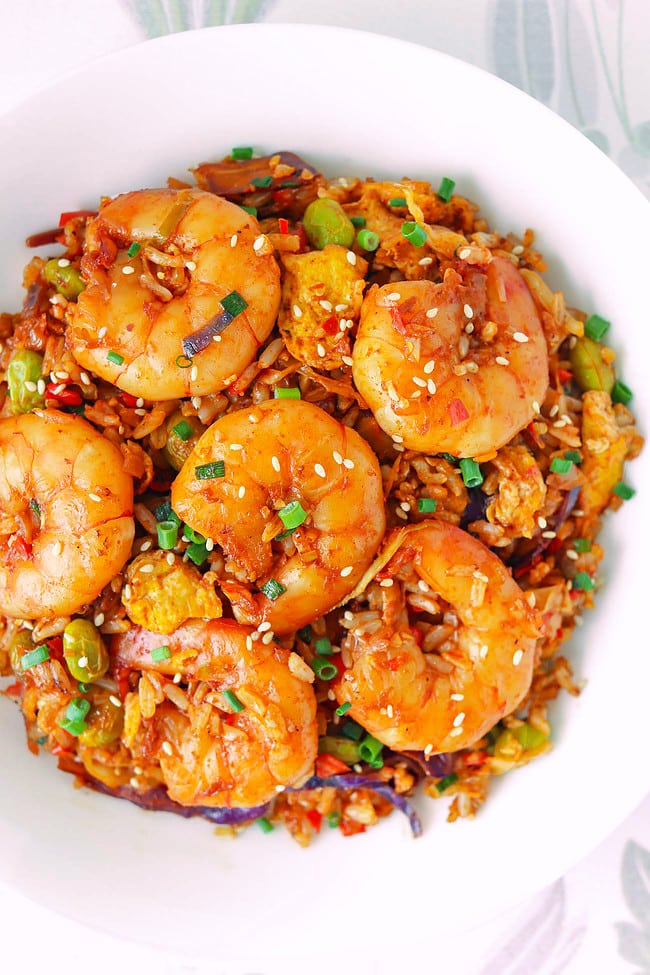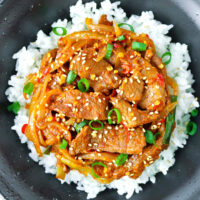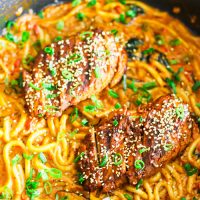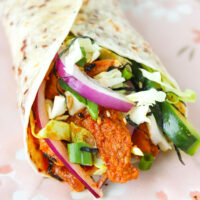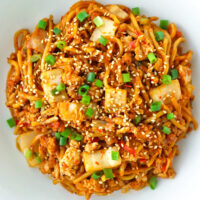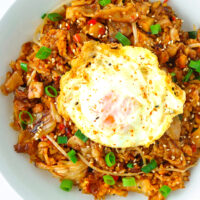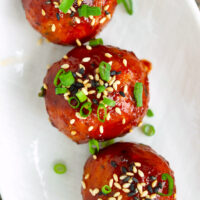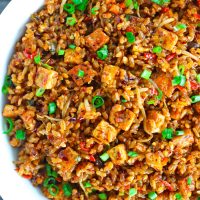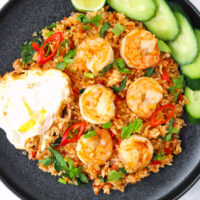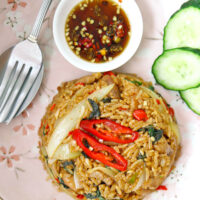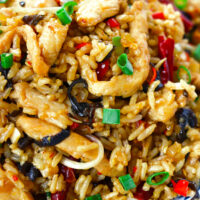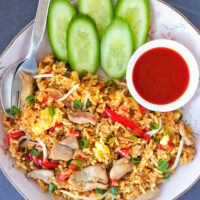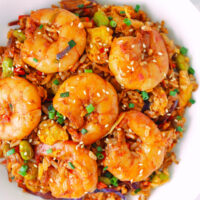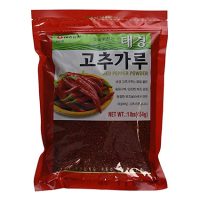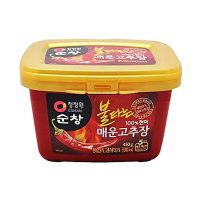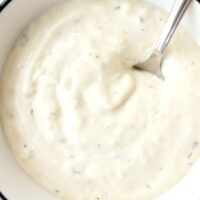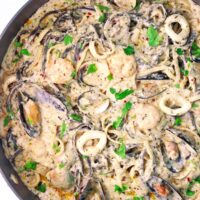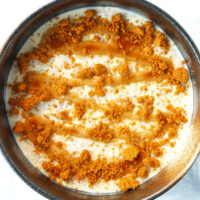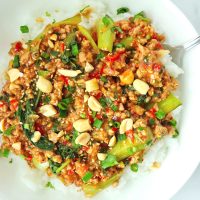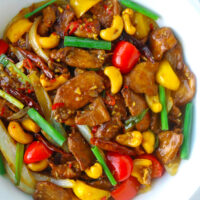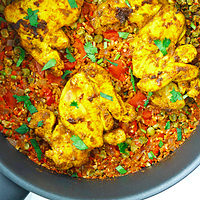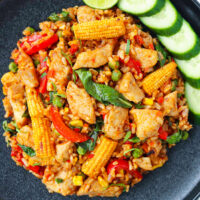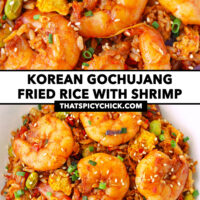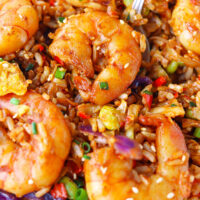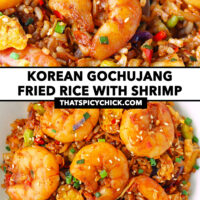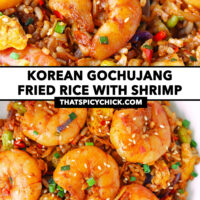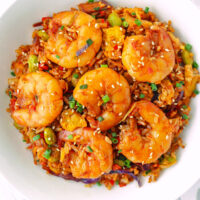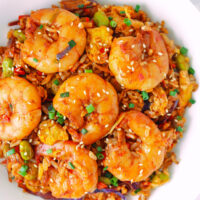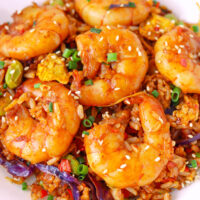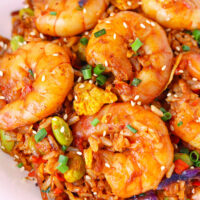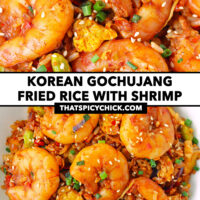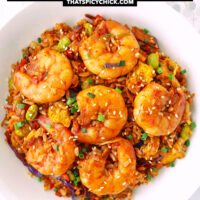Gochujang Fried Rice
This post contains affiliate links.
Juicy jumbo shrimp, fragrant aromatics, veggies and rice get tossed in a savory and spicy-sweet gochujang infused sauce in this Gochujang Fried Rice! It’s ready in under 30 minutes, customizable with your favorite protein and veggies, and vegetarian/vegan and gluten-free adaptable.
If you’re looking for a simple weeknight fried rice with incredible Korean style flavors, look no further! This Korean Gochujang Fried Rice (bokkeumbap) is packed with a TON of flavor and so easy to make.
We have:
- Juicy jumbo shrimp.
- Colorful veggies. Onion, frozen shelled edamame and store-bought tri-color slaw salad mix (carrots and red and green cabbage) for convenience.
- Fragrant aromatics. Garlic, ginger, spring onion and spicy red chilies.
- Scrambled egg. Because fried rice always tastes better with egg!
- Fluffy long grain rice. White, brown, red rice – whatever you love works!
- A DELICIOUS stir-fry sauce infused with the spicy and smoky flavors of gochujang with a hint of tang and sweetness!
All you need is one wok, 30 minutes and this gochujang fried rice is on the table and ready to be devoured! You can enjoy it on its own as a main dish or as a side with other dishes.
This is a high protein meal that is a weeknight winner and great for meal prep too. It’s also 100% customizable with your favorite protein and whatever veggies you have in your crisper drawer or freezer!
Make it tonight and I’m sure you’ll be making it over and over again!
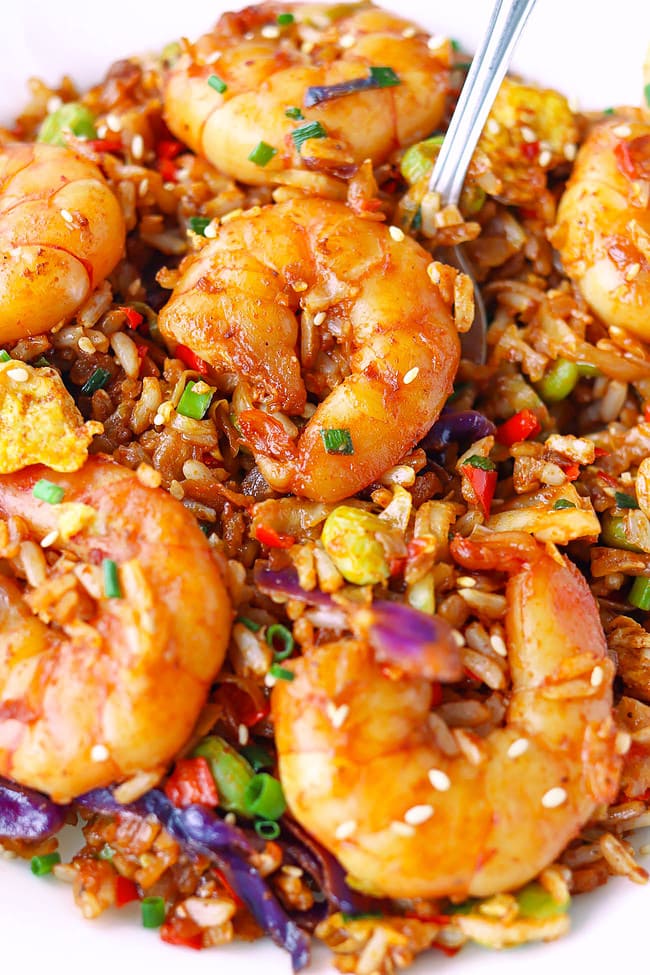
Why This Recipe Works
- Quick and easy to make. All you need is one wok and this fried rice is ready in under 30 minutes!
- BIG and BOLD flavors! Gochujang adds plenty of umami and this fried rice is full of the best spicy-savory and sweet flavors.
- High in protein. This is a hearty and healthy high protein meal with 42 grams of protein per serving thanks to the fried rice containing shrimp, edamame and egg.
- Customizable. You can use your favorite protein (chicken, pork, beef, tofu, etc.) instead of shrimp and any of your preferred stir-fry friendly veggies!
- Meal prep friendly. Double the ingredients to make 4 servings and enjoy it for lunch or dinner throughout the week.
Ingredient Notes and Substitutes
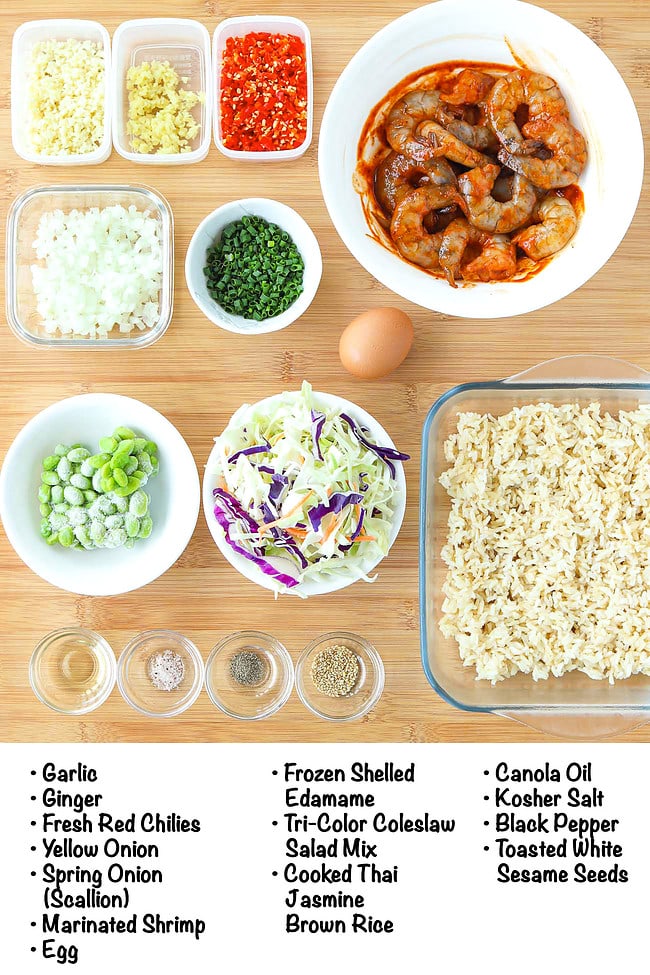
- Shrimp (or prawns): I used jumbo sized 16/20 (that means 16 to 20 pieces per pound) peeled and deveined shrimp and highly recommend them for the best flavor and texture. They won’t shrink as much during cooking. However, any size that’s not too small will work well. I’ve marinated the shrimp with gochujang (Korean chili pepper paste), low sodium light soy sauce, ground black pepper and a splash of sesame oil.
- Cooked Thai Jasmine Rice: I used cooked day-old chilled Thai jasmine brown rice. Cooked white jasmine rice or any long grain rice works best for making this fried rice. (If you don’t have cooked refrigerated leftover rice on hand, see ‘Cook’s Tips’ section below for how to make rice for fried rice quickly.)
- Veggies: We have yellow onion, frozen shelled edamame, and tri-color coleslaw salad mix which consists of red and green cabbage and carrots for convenience. You can also slice carrots and cabbage separately if you can’t find the readymade slaw mix easily. You’re welcome to use any stir-fry friendly veggies you have in your crisper drawer or freezer. See the ‘Variations’ section below for some ideas.
- Aromatics: Garlic, ginger, spring onion (scallion/green onion) and fresh red chilies. I used Thai Bird’s Eye red chilies which are quite spicy. Feel free to use any type of chilies that are easily available to you. Adjust the quantity to taste based on your spice level preference.
- Egg: I used just one in this gochujang fried rice. Feel free to use more if you’d like to add more protein or just love plenty of eggs in your fried rice.
- To Serve: Toasted white or black sesame seeds and more chopped spring onion.

- Gochujang: A fermented Korean chili pepper paste that comes in small tubs and is full of umami. Its color is a shade of dark red and it’s spicy-sweet and smoky in flavor, not just pure spicy. I used an extra spicy one from Chung Jung One brand, but regular spice level gochujang is great too. Find it in the Asian aisle of a well-stocked supermarket with international ingredients, Asian and Korean supermarkets or purchase it online.
- Low Sodium Light Soy Sauce: Adds savory umami flavors to the marinated shrimp and fried rice sauce.
- Gochugaru: A Korean hot pepper powder. Look for it in a Korean grocery store or purchase it online. Depending on the brand, some gochugaru powders may be quite spicy so adjust the quantity to taste. Substitute with chili powder or leave it out completely if you prefer a milder fried rice.
- Distilled White Vinegar: For a hint of acidity to balance out the spicy and sweet flavors.
- Sesame Oil: For fragrant toasted sesame aromas.
- Granulated Sugar-Free Sweetener: To balance out the spicy flavors, I added a pinch of Wholesome Zero Sugar. It’s a calorie-free and sugar-free erythritol based sweetener. Feel free to use any other sugar-free sweeteners made from stevia, monk fruit, etc. You can also use regular granulated white sugar, or honey or pure maple syrup if you prefer to use a natural sweetener.
Full ingredient list and amounts are in the recipe card below.
How to Make Gochujang Fried Rice
1. Cook the marinated shrimp. Use a large nonstick wok to cook the shrimp on both sides until just cooked. Transfer to a clean bowl and set aside.
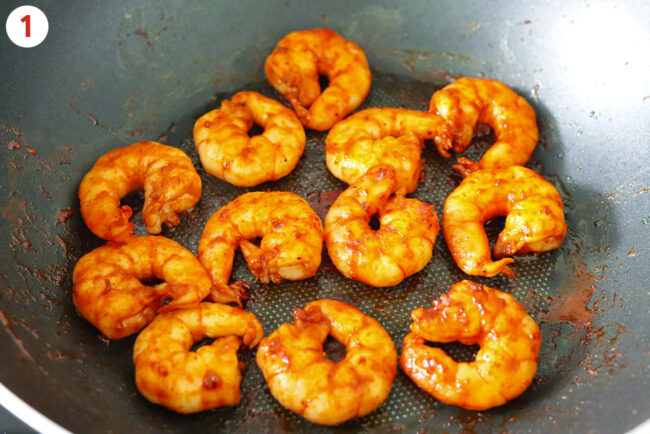
2. Stir fry the aromatics. Stir-fry the yellow onion, spring onion white and light green parts, ginger, garlic and red chilies until fragrant.
3. Add the veggies. Add the tri-color coleslaw salad mix and edamame and toss to combine.
4. Cook the egg. Push everything to the side of the wok and pour in the egg. Let it set for a few seconds then break it up into pieces and toss to combine with everything else.
5. Add the rice and sauce. Stir-fry for 1 minute or until every grain of rice is evenly coated with the sauce.
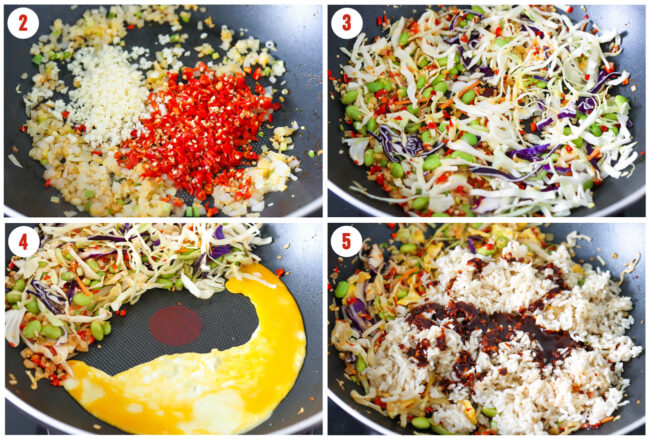
6. Season and add the shrimp. Season with kosher salt and ground black pepper. Add the cooked shrimp and toss to combine.
7. Toss through the spring onion dark green parts. Reserve some for garnish.
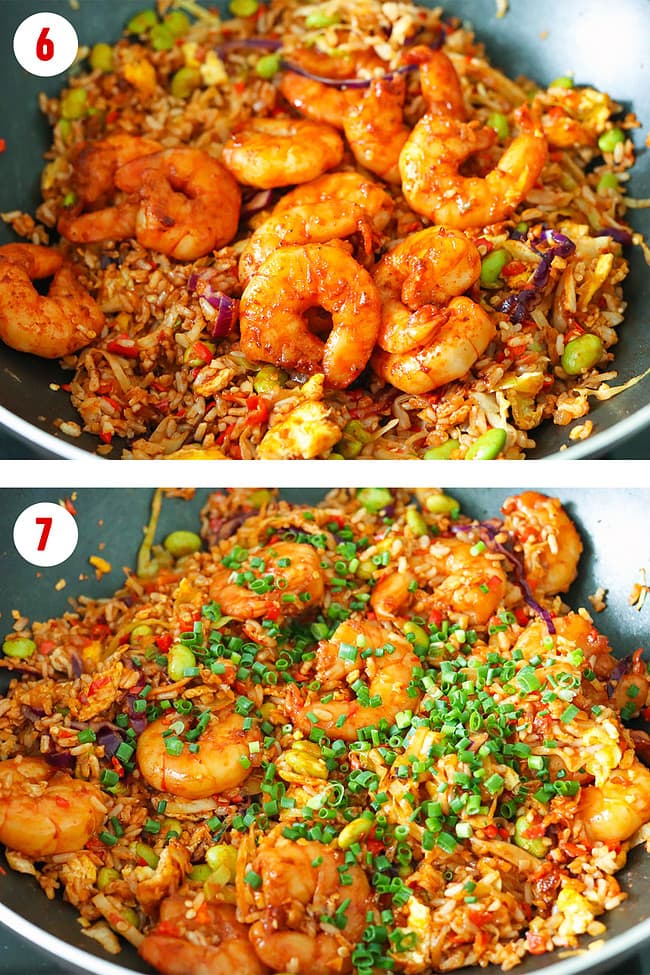
Serve! Divide evenly onto plates and garnish with toasted sesame seeds and spring onion. Serve immediately and enjoy!
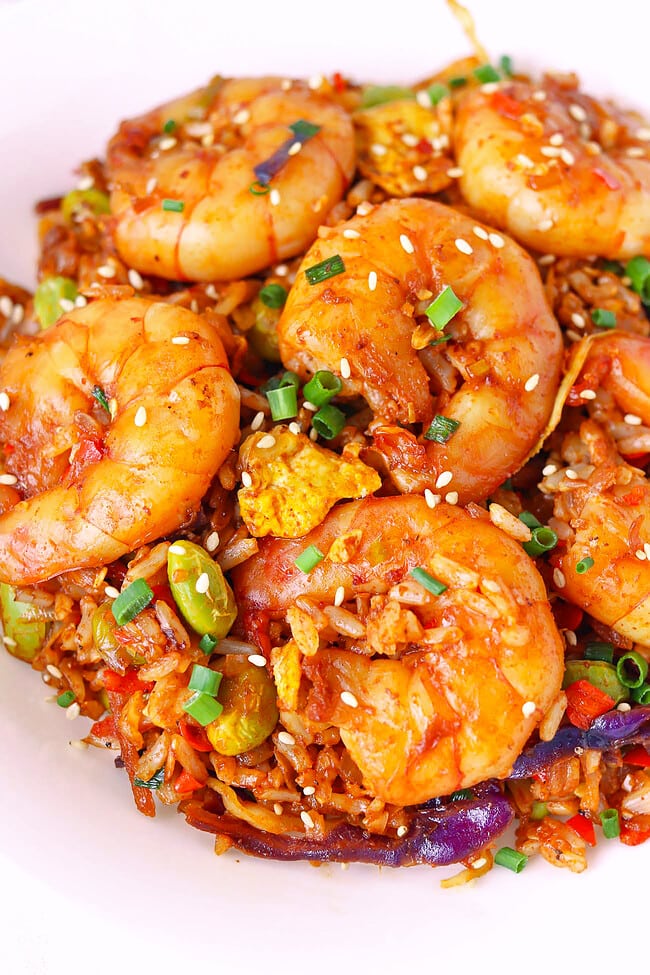
Full detailed instructions are in the recipe card below.
Cook’s Tips
- To prepare rice for fried rice quickly. Cook the rice in a pot on the stove or in the rice cooker with water as you normally would. Once cooked, fluff with a fork and spread it out on a large baking tray. Place in the freezer for 20 minutes or fridge for 30 minutes while you prepare the rest of the ingredients. This cools the rice quickly and also help with drying up the moisture.
- Use a large nonstick wok or heavy bottomed deep skillet. A nonstick surface allows us to use less oil to cook the fried rice and a wok helps to create the restaurant-style ‘wok hei’ (breath of the wok) smoky flavors. If you don’t own a wok, the next best cooking vessel would be a deep skillet/sauté pan. It has enough surface area for the ingredients to have direct contact with the hot pan and prevents the fried rice from become mushy and soggy.
- Add a splash of oil before adding the egg if your wok or pan is not completely nonstick. you may need to add a splash of oil to cook the egg to prevent sticking.
- Make it milder. If you’re not big on spice, use less of or omit the chilies and gochugaru. Use a little less gochujang too but keep in mind this fried rice is meant to be a spicy gochujang fried rice. You don’t want to use too little and end up a with a bland fried rice.
- Serve with a sunny side up fried egg. Instead of scrambling the egg, serve each portion with a runny sunny side up egg like in this kimchi fried rice with pork belly.
- Make it for meal prep. This fried rice will keep in the fridge for up to 3 days if stored properly in airtight sealed containers. If you switch the protein to chicken, it will last for up to 4 days in the fridge. Double the recipe ingredients by clicking the ‘2x’ button in the recipe card to make 4 servings to enjoy throughout the week for lunch or dinner. Be sure to use a large enough wok or pan for cooking so that the fried rice doesn’t become mushy. I recommend cooking in two batches if your wok is not large enough. To reheat leftovers: Reheat leftovers for 1-2 minutes on high in the microwave or until hot throughout.
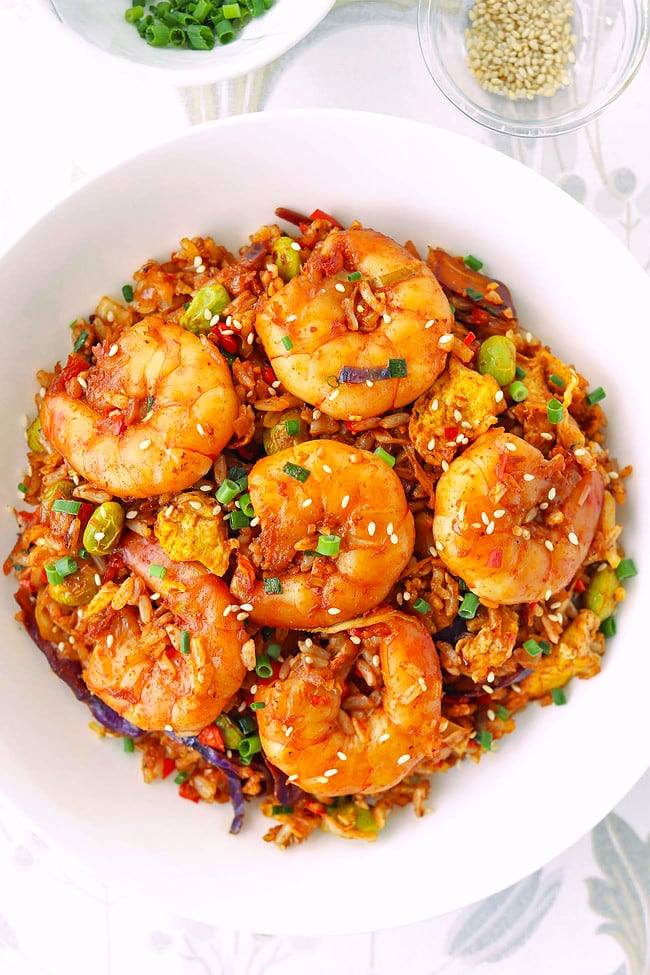
FAQs
Find it in the international foods section or Asian aisle in mainstream supermarkets that are well-stocked with international ingredients. It is also available in Asian supermarkets and will be in the sauces and pastes section or Korean ingredients aisle depending on the supermarket.
Definitely! At the end of cooking, sprinkle freshly grated mozzarella, gouda, provolone, fontina or other easy to melt cheese on top of the fried rice and cover for 2-3 minutes until the cheese has melted. Then plate and add garnishes.
Use tofu or tempeh for the protein or simply make it with eggs. You could also use a plant-based meat substitute such as veggie chicken, pork or beef pieces. If you want to make a vegan gochujang fried rice, omit the eggs too.
Variations
- Use a different protein. Switch out the shrimp for diced boneless and chicken breasts or thighs, sliced pork tenderloin (fillet) or beef flank or skirt steak. You can even make this with cooked spam.
- Use different veggies. Any stir-fry friendly veggies will taste delicious in this fried rice. Some options are mung bean sprouts, sliced mushrooms, frozen mixed veggies (thaw them first in the microwave), broccoli florets, broccolini, sliced or shredded brussels sprouts, green garden peas, sugar snap peas, snow peas, bell pepper, zucchini, etc.
- Make it gluten-free. Use a gluten-free gochujang such as Wholly Gochujang and a gluten-free low sodium light soy sauce.
- Serve each portion with a fried egg. Instead of scrambling the egg in the fried rice, fry two eggs separately first in a pan until cooked to your liking. Serve on top of each serving of fried rice.
- Make it vegetarian. Swap the chicken for crispy pan-fried tofu cubes or tempeh. Add the shrimp marinade ingredients to the stir-fry sauce instead. The pan-fried tofu will get coated with the sauce when you add them to the wok.
- Make it vegan. Same as for making it vegetarian but omit the egg too.
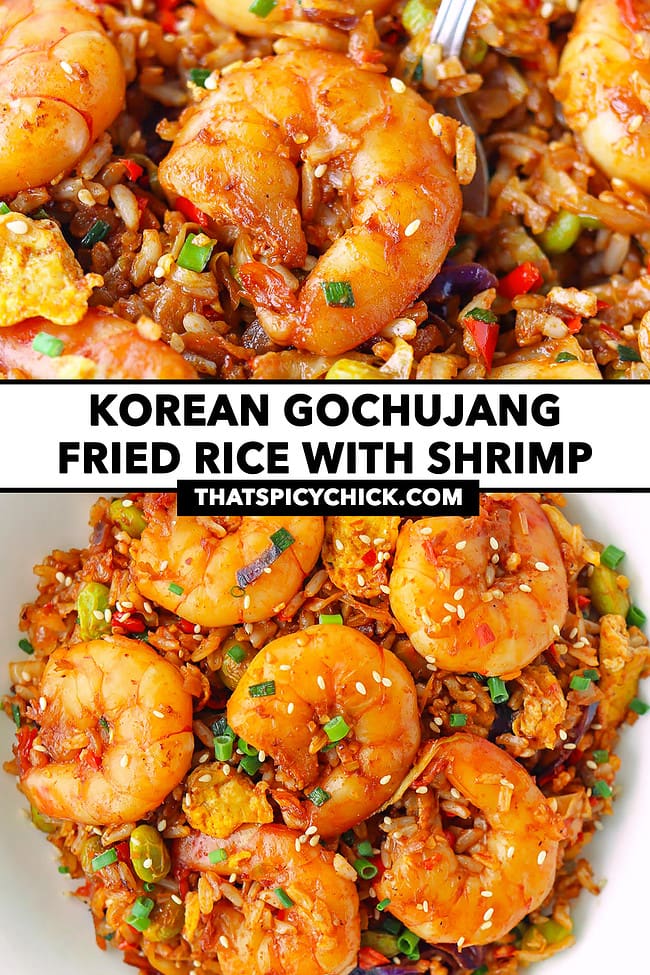
MADE THIS RECIPE? If you make this recipe, leave a comment below and let me know how you liked it! Take a photo and tag it with @thatspicychick on Instagram and hashtag it #thatspicychick and I’ll be sure to share your masterpiece!
STAY CONNECTED! You can also follow me on Pinterest, Facebook or Instagram. Sign up for my email list to get my latest recipe in your inbox weekly!
More Korean Recipes
More Fried Rice
Gochujang Fried Rice
Juicy jumbo shrimp, fragrant aromatics, veggies, and rice get tossed in a savory and spicy-sweet gochujang infused sauce in this Gochujang Fried Rice! It’s ready in under 30 minutes, customizable, and so DELICIOUS!
- Prep Time: 15
- Cook Time: 10
- Total Time: 25 minutes
- Yield: 2 1x
- Category: Dinner
- Method: Stir-fry
- Cuisine: Korean
Ingredients
For the Shrimp:
- ½ TBLS Gochujang (Korean chili pepper paste – note 1)
- 1 TSP Low Sodium Light Soy Sauce
- ⅛ TSP ground Black Pepper
- ¼ TSP Sesame Oil
- 300 grams / 10.6 ounces peeled and deveined Shrimp (or prawns – size 16/20 recommended)
- 1 TSP Peanut Oil (or any neutral oil with a high smoke point), for cooking
For the Sauce:
- 1 TBLS Low Sodium Light Soy Sauce
- 30 grams / 1 TBLS Gochujang
- 1 TSP Distilled White Vinegar
- ½ TSP granulated Sugar-Free Sweetener (I used Wholesome Zero Sugar – note 2)
- ¼ TSP Gochugaru (Korean hot pepper powder – note 3), to taste
- ½ TSP Sesame Oil
For the Fried Rice:
- 50 grams / ¼ medium Yellow Onion – finely chopped
- 20 grams / 1 medium Spring Onion (Scallion/Green Onion) – finely chopped, white and light green parts separated from the dark green parts
- 8 grams / ≈ 1 TBLS minced Ginger
- 25 grams / 4-5 Garlic cloves – minced
- 35 grams / 9-10 fresh Red Chilies (Thai Bird’s Eye or any other small hot red chilies – note 4*), to taste – finely chopped
- 1 large Egg – lightly beaten
- 100 grams / 1 heaped cup Coleslaw Salad Mix (red and green cabbage and carrots – note 5)
- 75 grams / ½ cup Frozen Shelled Edamame, thawed
- 239 grams / 1.5 cups cooked Thai Jasmine Brown Rice, day-old, chilled (100 grams / 3.5 ounces uncooked weight)
- ¼ TSP ground Kosher Salt, to taste
- ⅛ TSP ground Black Pepper, to taste
- To Serve: Toasted white or black sesame seeds, reserved chopped spring onion
Instructions
Prep:
- Marinate the shrimp: In a large bowl, mix together the gochujang, low sodium light soy sauce, ground black pepper and sesame oil until combined well. Add the shrimp and mix to coat, set aside.
- Make the sauce: Mix together the low sodium light soy sauce, gochujang, distilled white vinegar, gochugaru, granulated sugar-free sweetener and sesame oil in a measuring cup (for easier pouring) or small bowl until combined well.
- Prepare the fresh ingredients: Chop the yellow onion, spring onion (separating the white and light green parts from the dark green parts), ginger, garlic, and fresh red chilies as indicated in the ‘ingredients’ section. Crack the egg into a bowl and lightly beat.
For the Gochujang Fried Rice:
- Cook the shrimp: Heat 1 teaspoon peanut oil in a large nonstick wok or heavy bottomed deep skillet over medium-high heat. Add the shrimp and spread the pieces out in the wok. Cook for 2-3 minutes, turning the pieces over halfway, until just cooked. Transfer to a clean bowl and set aside. Scrape out and discard any burnt marinade bits if needed.
- Stir fry the aromatics: Heat the remaining ½ tablespoon of peanut oil in the wok over high heat. Add the yellow onion, spring onion white and light green parts and ginger. Stir-fry for 30 seconds until the onion starts to soften. Add the garlic and red chilies and stir-fry for 30 seconds until fragrant.
- Add the veggies: Add the tri-color coleslaw salad mix and edamame. Stir-fry for 30-40 seconds to combine.
- Cook the egg: Push everything to the side of the wok and pour in the egg. Allow to set for 20 seconds then break it up into pieces and toss to combine with everything else.
- Add the rice and sauce: Add the rice and pour the sauce on top. Stir-fry for 1 minute or until every grain of rice is evenly coated with the sauce.
- Season and add the shrimp: Season with kosher salt and ground black pepper. Add the cooked shrimp and toss for 1 minute to combine.
- Toss through spring onion: Toss through most of the spring onion dark green parts (reserve some for garnish) and switch off the heat.
- To Serve: Divide evenly onto plates or into bowls. Garnish with toasted white sesame seeds and the reserved spring onion dark green parts. Serve immediately.
Notes
- Gochujang. This is a fermented Korean chili pepper paste that comes in small tubs and is full of umami. Its color is a shade of dark red and it’s spicy-sweet and smoky in flavor, not just pure spicy. I used an extra spicy one from Chung Jung One brand, but regular spice level gochujang is great too. Find it in the Asian aisle of a well-stocked supermarket with international ingredients, Asian and Korean supermarkets or purchase it online.
- Granulated Sugar-Free Sweetener. I used Wholesome Zero Sugar which is a calorie-free and sugar-free erythritol based sweetener. Use any other sugar-free sweetener made from stevia, monk fruit, etc. you like. You can also use regular granulated white sugar, or honey or pure maple syrup if you prefer to use a natural sweetener.
- Gochugaru. This is a Korean hot pepper powder. Look for it in a Korean grocery store or purchase it online. Depending on the brand, some gochugaru powders may be quite spicy so adjust the quantity to taste. Substitute with chili powder or leave it out completely if you prefer a milder fried rice.
- Red Chilies: Use less or omit for a milder fried rice.
- Coleslaw Salad Mix: You can also use matchstick cut carrots and sliced cabbage instead of a store-bought coleslaw salad mix. I prefer the latter for convenience in this recipe.
- Meal prep option and reheating leftovers. This fried rice will keep for up to 3 days if stored properly in the fridge in airtight sealed containers. If you switch the protein to chicken, it will last for up to 4 days in the fridge. Double the recipe ingredients by clicking the ‘2x’ button at the top of the recipe card to make 4 servings. Be sure to use a large enough wok or pan for cooking so that the fried rice doesn’t become mushy. I recommend cooking in two batches if your wok is not large enough. To reheat, microwave on high for 1-2 minutes until hot throughout.
- See ‘Variations’ section in the post above if you’d like to customize this fried rice.
Nutrition
- Serving Size: ½ of recipe
- Calories: 564
- Sugar: 12.3g
- Sodium: 1622.1mg
- Fat: 15.1g
- Saturated Fat: 8.8g
- Unsaturated Fat: 7.7g
- Trans Fat: 0g
- Carbohydrates: 71.1g
- Fiber: 8.7g
- Protein: 42.4g
- Cholesterol: 93mg
This post may contain affiliate links. We are a part of the Amazon Services LLC Associates Program, an affiliate advertising program designed to provide a means for us to earn a small commission (at no extra cost to you) by linking to Amazon.com and affiliated sites. The nutritional information provided is approximate and can vary based on several factors. It should only be used as a general guideline. For more information, please see our Disclosure.

